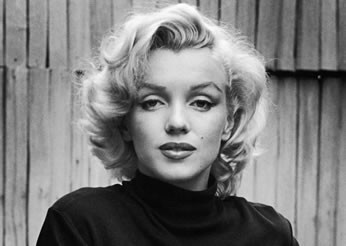To write about Marilyn Monroe means to face the tabula rasa of everything that has been written and said about her so far, including all the gossip, and turning your own eye on the other side of the condensed imagination that was created by her myth. The story about bodies can be written and imagined. All those looks that were focused on the myth called Marilyn are also different forms of longing. Therefore, we should start from the body, a naked body that was dropped on the Hollywood assembly line. She was born on June 1, 1926. Her father died in an accident that was never explained and her alcoholic mother systematically mistreated her. Many Americans could not help themselves and not identify with her hard childhood torn between the hell of her family and purgatory of many orphanages. Early on she started to make provocative photographs and triumphantly entered the world of film when John Huston gave her a small role in The Asphalt Jungle. Marilyn appeared in Huston’s film very briefly and played the role of a gangster’s doll. Nevertheless, sometimes less is more. One pajama was enough. Her presence/absence was noticed.
Let us stop here for a moment. To list all her roles would be a waste of time. Maybe that is the reason why we are celebrating the 90th anniversary of her birth with two film portraits. In two films, All About Eve by Joseph Mankiewicz and in Huston’s The Asphalt Jungle (both made in 1950), she appeared in small supporting roles. In the first one she came to a party, hosted by Bette Davis, accompanied by the cynical and manipulative theatre critic George Sanders, and spoke the famous one-liner: 'Why do they always look like unhappy rabbits?'. At that same party she was surrounded by much more famous and experienced actors than herself. However, she knew already then how to cunningly react to the word game of words 'sable' and 'Gable'. And the other portrait is in one of the best comedies of all time, Some Like It Hot Billy Wilder in which she portrayed the ukulele musician Sugar Kane, born as Kowalchick, member of the female band 'Sweet Sue and Her Society Syncopators'. By then she was already famous. In fact, there were many 'sables' and Gables in her life. For Marilyn the latter meant the point/river of no return in The Misfits. However, in it her body does not invite men to a shameless erotic itching but to desperate screams of loss.
Nevertheless, to truly understand her irresistible Sugar Kane, we have to go back to another great film by Wilder in which she starred before he hired her for his master-piece Some Like It Hot. The Seven Year Itch is reduced to a look that is constantly fighting itself in order to escape the trap of mutually eroticized contacts. Its protagonist tries not to see i.e. to resist Marilyn’s charm, but is unable because his instinct is stronger. Marilyn plays his neighbor. She is not real, but she is not imaginary either. She resides in the area of distance, but turns into its sovereign ruler thanks to the provocative white dress that became the ultimate fetish in the genesis of pop imagery. When she steps onto the underground grate, the lifting of that same dress becomes a destructive proof of Wilder-esque slapstick. Namely, the protagonist is simultaneously crazy, blind and a masochist. He is following an image of a woman that does not exist in reality because he is tired of the language and rules imposed on him by his family and marriage constraints (his wife and son left town for vacation). However, erotic phantasmagoria do not have an age, name or conditions. At a glance, it is a diametrically opposite film when compared to Henry Hathaway’s Niagara, which focuses on betrayal, death and gilt, even though in it also Marilyn’s figure becomes central and enigmatic, distant and mysterious.
What the constraints of his marriage meant to Tom Ewell in The Seven Year Itch, that is what constraints of their dresses mean to Tony Curtis and Jack Lemon in Some Like It Hot. Sugar Kane and her merry band infatuated them beyond reason, but their manly lust must be concealed behind make-up, cute hats and dresses. Namely, Marilyn represented a dream because she was a dream herself. A dream for Ewell, Daphne and Josephine. A dream that, during her short career, became the driving wheel of the old Hollywood in production of myths and its unreal, abstract and cerebral figures. That is how she remains remembered also in Warhol’s art pieces, reduced to eternal duplication and copying. (Dragan Rubeša)
